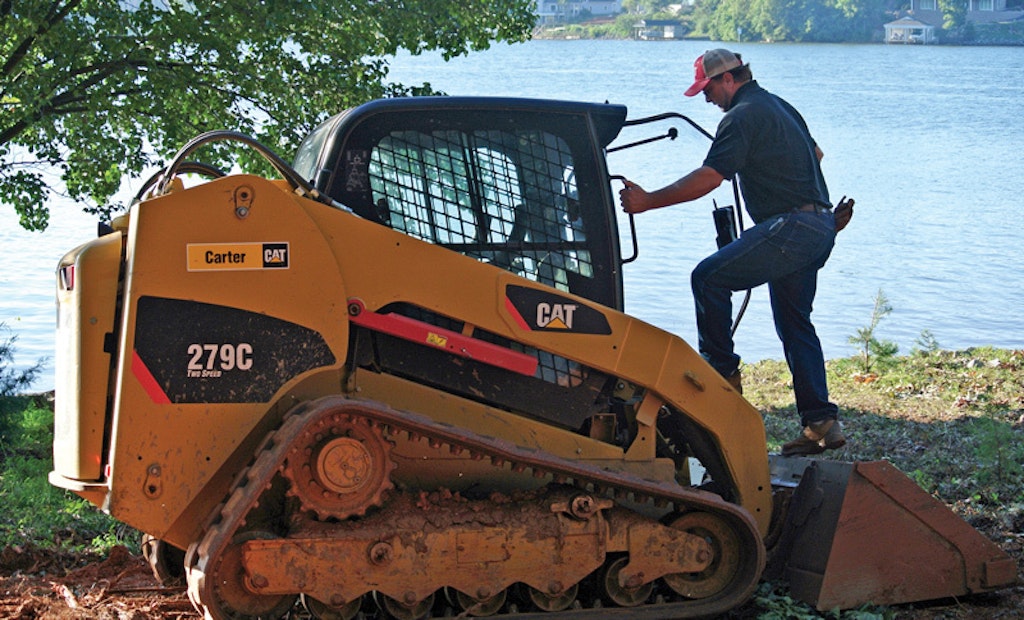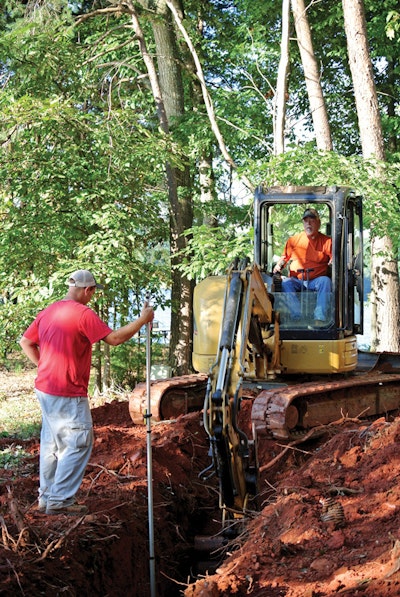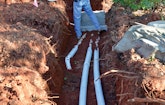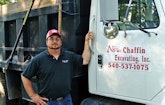
Interested in Systems/ATUs?
Get Systems/ATUs articles, news and videos right in your inbox! Sign up now.
Systems/ATUs + Get AlertsBehind most successful people is a mentor, and Dewey Chaffin of Chaffin Excavating in Bedford, Va., was Emmett Mitchell’s trusted advisor.
In 1991, Mitchell was fresh out of high school and seeking a career that didn’t involve his father’s logging business. Excavating, grading and installing conventional stone-and-pipe septic systems seemed the perfect fit for the young man who loved being outdoors and operating heavy equipment.
The two men became business partners before Chaffin retired and Mitchell took over the company in 2004. Building upon Chaffin’s lessons, Mitchell carved a niche in the onsite industry by specializing in steep slope installations and system repairs. As his expertise and reputation grew, design engineers, private alternative onsite system evaluators and general building contractors consulted him to help solve difficult problems.
Referrals from this group and homeowners generate all of Mitchell’s business. He shies from opportunities to expand, preferring to subcontract the work rather than spread himself too thin. “I’m a hands-on individual,” he says. “I want to keep the company small enough so I will always be the one holding the reins.”
Glimpsing the future
The Blue Ridge Mountains and Parkway define the west boundary of Bedford County, with James River to the north and Smith Mountain Lake to the south. The 764-square-mile west-central county has rolling to hilly terrain with elevations from 800 feet to 4,200 feet above sea level.
The Smith Mountain Lake area sits on shale rock, requiring shallow installations. In 2002, Shrader Engineering & Land Surveying hired the partners to install their first MicroFAST advanced treatment system with drip disposal at a lake home. Chaffin and Mitchell received on-the-job training from Mike Burch, a Bio-Microbics distributor.
“It was an epiphany,” says Mitchell, 40. “The system would solve many of the area’s installation and repair problems. We could see lots of changes coming and the need to learn the technology. Dewey left it up to me because I was the younger buck.”
Other contractors were equally proficient at installing ATUs on fairly level ground, but balked at working on lots with slopes averaging 35 percent. (State code prohibits installations on grades steeper than 40 percent.) Chaffin, who came from mountainous southwest Virginia, taught Mitchell the fine art of working safely on scarps.
Those installation qualities attracted the attention of engineers, soil evaluators and county health department members who discussed difficult repair jobs with Mitchell. He occasionally visited sites to ensure that he could do the job as they envisioned it. When designers specified new treatment products, Mitchell became a certified installer for Advantex (Orenco), MultiFlo (Consolidated Treatment Systems), Puraflo (Anua), and Ecoflo (Premier Tech Aqua) systems.
Mitchell joined the Virginia Onsite Wastewater Association to earn continuing education credits, and received his alternative onsite sewage system installer license and Class A contractor license from the state Department of Health. The Class A rating enables him to bid on any size job. He’s also a certified land disturber to meet the state’s requirement of having one person responsible for controlling on-site erosion.
Building a team
A partnership between the men, formed in 2001, lasted three years until Chaffin retired. During that time, he taught Mitchell how to run the business. “He was an incredible teacher, but he couldn’t teach me how to handle the stress of being 100 percent responsible for the company and employees,” says Mitchell. “That was one of my biggest challenges.”
In 2005, Mitchell married Lisa Daubenspeck. Besides running the home office, she provided critical support and advice. “When I first took over, I had lofty plans that included bigger, better toys and more of them,” says Mitchell. “Lisa balanced my enthusiasm with common sense. She doesn’t often voice her opinion, but when she does, I listen.”
Mitchell hired a full-time employee to replace Chaffin, then added two more. “It probably was ignorance, but at that age I was ready for the challenge,” he says. Within a short time, however, Mitchell found himself running from one site to the next instead of operating machinery and supervising work. “I pulled back,” he says. “It takes only one bad job to jeopardize a company’s reputation, and my reputation is all I have.”
From 2004 to 2009, Mitchell had three employees. By 2006, they were installing 80 systems per year, with 70 percent pump-backs – setting the tanks on the lake side and pumping back to the drainfield. After 2009, installations fell to 20 or 30 per year, forcing Mitchell to release one employee. His right-hand man is Danial Johnson, who joined the company in 2006. He brought an extensive onsite background and a conventional installer’s license.
“Danial was soon playing such a major role that now he’s my project manager,” says Mitchell. “Because of him, Lisa and I can take vacations and never worry while he’s in charge.”
Today, installing pump-back and gravity systems are 50 percent of their work, and advanced systems comprise the remainder. General excavating generates 30 percent of annual revenue. The crew clears lots, installs driveways, excavates basements, backfills, final grades and seeds with straw. “Many general building contractors like dealing with one subcontractor,” he says. “As far as dirt work, we’re a turnkey operation.”
You did what?
Referrals bring in many homeowners with sewage backing up or ponding in the yard. For repairs, Mitchell contacts the county health department and calls Hubert Ayers of Septic System Services in Vinton, Va., to pump the 1,000-gallon septic tanks. “Local health departments understand that customers need the work done pronto,” he says.
Mitchell’s crew meets a representative on-site, then they dig test holes and the official tells them where to install the new drainfield, how many lines to lay and how deep. “We often complete the repair that day,” says Mitchell. “The health department even waives the repair application fee to expedite matters.”
Systems occasionally fail because tanks were never pumped, but the main reason is homeowners planting trees in the wrong places. During a recent repair, Mitchell found a giant maple tree in the center of the absorption bed. “It took the whole drainfield,” he says. “The trunk was so massive that we kept trimming it with the backhoe to get it into the dump truck.” Mitchell blames lack of homeowner education for most system failures.
While some lots have space for replacement drainfields, most go in the original location using an excavate-and-drag technique for deep repairs. Mitchell or Johnson first use a Caterpillar 420E backhoe to reach virgin soil, then create a space for the drag box, which has a mechanism to feed 100-foot rolls of 4-inch corrugated pipe.
“Trenches are often 7 to 11 feet deep,” says Mitchell. “I don’t put anyone in them because it isn’t safe.” While Johnson uses a Caterpillar 279C compact track loader to fill the box with stone and keep it full, Mitchell excavates and pulls the unit forward. The box lays 4 inches of stone followed by the pipe and 3 inches of cover, while a banksman shoots grades and prevents the corrugated pipe from kinking as it unrolls. The men then cover the stone with hand-shaken straw or hay to avoid entering the trench.
The soil from digging the first trench goes topside. Then the soil excavated from the second trench covers the first line. Material from the original drainfield becomes backfill.
Commercial Scale
In 2011, Dan Early, P.E., and Scott Easter, P.E., of ACS Design in Roanoke, Va., hired Chaffin Excavating to install a 10,000 gpd Magellan packaged wastewater treatment plant (Contech Engineered Solutions) at an industrial facility with high-strength waste exceeding the state’s Department of Environmental Quality discharge limits to the sewer. “We’d worked with Dan and Scott installing residential advanced treatment systems, but this was our first commercial installation with advanced treatment,” says Mitchell.
The plant came in three 8-foot-diameter by 45-foot-long DuroMaxx steel-reinforced polyethylene vessels (Contech Engineered Solutions). The first two had compartments for primary treatment, the moving bed bioreactor and clarification; the last was a 7,000-gallon flow equalization tank for a total capacity of 18,000 gallons. “This was a well-established industrial park with only one place for the tanks – exactly where we hit a 30- by 40-foot-long 2-foot-deep rock layer,” says Mitchell.
He rented a hoe ram hydraulic demolition hammer for the excavator to hammer out the rock, then hired a crane to set the tanks. “It was the same work we do every day, only on a larger scale, so it took more time,” says Mitchell.
Have Excavator, will travel
ACS Designs then hired Mitchell to lay sewer and water pipes for 112 campsites built on terraces overlooking Smith Mountain Lake.
The crew set 12 concrete septic tanks varying from 1,000 to 1,500 gallons, and an 8,500-gallon PumpMaxx HE packaged pump station (AppTech Solutions) in an 8-foot-diameter by 40-foot-long reinforced poly vessel. A pressure-sensing transducer signals the programmable logic controller to activate two 5 hp alternating pumps in the wet well. They send effluent 3,000 feet through a 3-inch force main to the sewer. Valves, instrumentation and controls are in an equipment room at the front of the vessel. The rack-mounted control panel includes a main breaker, pump electrical controls and pump station level control.
To work on scarps, Mitchell or Johnson use the track loader to build a road to the first trench, then they level or bench the trench area. Returning with the 420E backhoe, they excavate to the required depth, placing the soil where they’ll dig the next trench on 11-foot centers. This soil is then compacted to form the bench for digging the next trench.
“The process is slower than working on flatter ground,” says Mitchell, who has a perfect safety record. “That’s why other contractors won’t take these jobs. They believe working faster makes more money.”
Except for a 970 John Deere compact tractor, Mitchell buys his equipment from Caterpillar. When not in the field, he parks them in a 24- by 60-foot building next to his 60- by 70-foot shop with two service bays on 91 acres. Mitchell used to replace equipment every two or three years, but now they’re lasting longer working fewer hours. “I have small payments left on two machines, and I won’t have to update anything for three or four years,” he says.
After holding the reins of Chaffin Excavating for 10 years, Mitchell is content to continue the status quo. He’s not interested in owning a website or launching marketing campaigns to grow the company. “I’m blessed,” he says. “When customers ask officials to recommend a contractor, Chaffin Excavating pops out of their mouths.”









